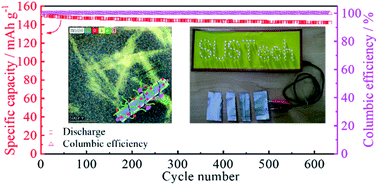An in situ photopolymerized composite solid electrolyte from halloysite nanotubes and comb-like polycaprolactone for high voltage lithium metal batteries†
Abstract
Solid Polymer Electrolytes (SPEs) exhibit great potential for application in high energy density solid-state lithium metal batteries owing to their excellent flexibility and high safety. However, the growth of lithium dendrites and poor interfacial contact between the electrolyte and electrode seriously hinder the wide commercial application. In this work, a composite solid electrolyte from halloysite nanotubes (HNTs), comb-like poly-ε-caprolactone (PCL), and lithium bis(fluorosulfonyl)imide (LiFSI) is fabricated via solvent-free in situ photoinitiated radical polymerization. On account of HNTs, the composite solid electrolyte (CSE) exhibits significantly improved room temperature ionic conductivity (6.62 × 10−5 S cm−1), a greater lithium transference number (0.55), and a higher electrochemical stability window (5.4 V) compared with the analog without HNTs (PSE). This is because the negatively charged outer silica surfaces of HNTs are enriched with Li+, while the positively charged aluminol inner surfaces accommodate FSI− anions, as clearly observed by TEM. As a bonus, the growth of lithium dendrites is remarkably alleviated. The superior electrochemical properties, in conjunction with refined interfacial contact by the in situ fabrication technique, enable the CSE-based lithium metal battery (at 1C and 60 °C for the LiFePO4 cathode) to have excellent cycling performance of high initial discharge capacity (155 mA h g−1), outstanding average coulombic efficiency (>99%), and extraordinary capacity retention (>92% over 600 cycles). Coupled with the high voltage LiMn0.5Fe0.5PO4 cathode (4.25 V), the solid-state lithium metal cell with the CSE also exhibits superior cycling performance, with an initial capacity of 134 mA h g−1 and a capacity retention of 87% over 250 cycles at 0.2C and 60 °C.



 Please wait while we load your content...
Please wait while we load your content...